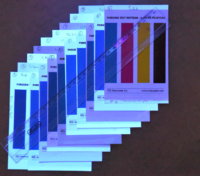- Joined
- Dec 27, 2014
- Messages
- 5,860
- Reaction score
- 6,984
- Points
- 363
- Location
- Germany
- Printer Model
- L805, WF2010, ET8550
I'm running a fading test since 2 weeks to compare various photo glossy papers how dye inks fade on these.
I'm using the same dye ink set, the same printer and driver settings and use a range of different photo glossy papers - Sihl, Tecco, HP, Canon and some more - most of them of the RC type with a PE barrier, the more expensive ones vs. the cc castcoated papers. This test does not cover any non-standard papers , special inks or other experimental actions like a GO overprint.
The samples are placed outside with some winter sun and freezing temperatures - ozone and UV will do their work.
I did a similar test about 2+ years ago showing quite some differences between the papers tested at that time, I 'm using now a few more papers - and at some different environmental conditions vs. the summer sun at that time. The first differences are becoming visible now, I'll give the patches some more time to show the variances more clearly for a more detailed report.
I'm using the same dye ink set, the same printer and driver settings and use a range of different photo glossy papers - Sihl, Tecco, HP, Canon and some more - most of them of the RC type with a PE barrier, the more expensive ones vs. the cc castcoated papers. This test does not cover any non-standard papers , special inks or other experimental actions like a GO overprint.
The samples are placed outside with some winter sun and freezing temperatures - ozone and UV will do their work.
I did a similar test about 2+ years ago showing quite some differences between the papers tested at that time, I 'm using now a few more papers - and at some different environmental conditions vs. the summer sun at that time. The first differences are becoming visible now, I'll give the patches some more time to show the variances more clearly for a more detailed report.

